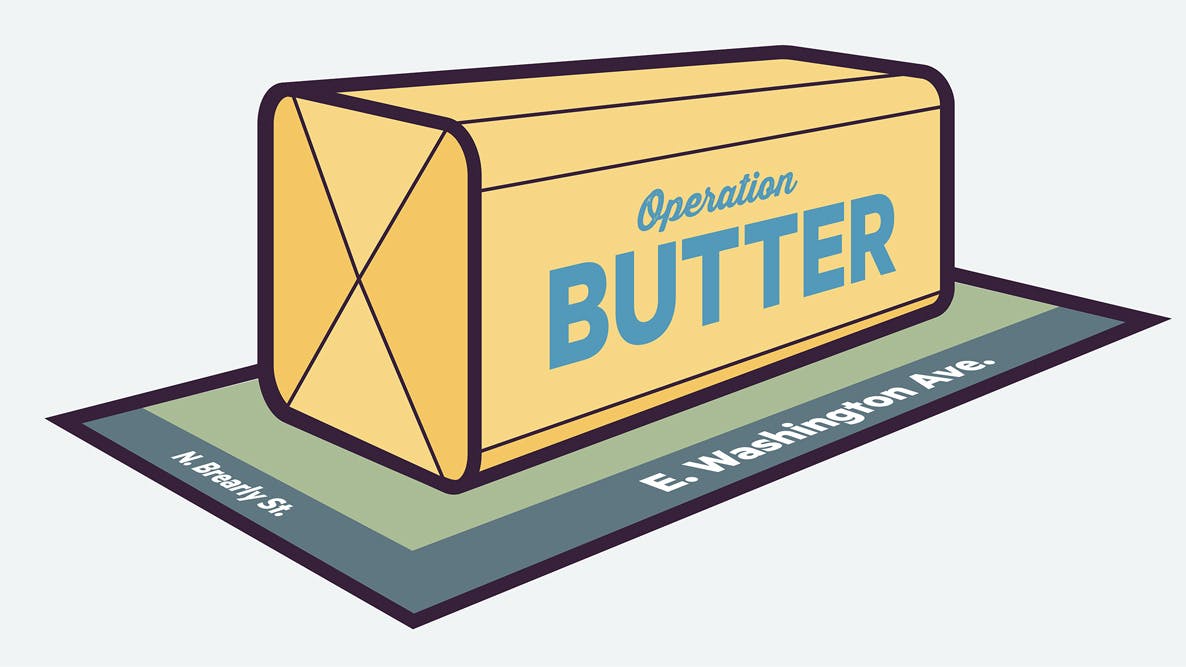Change is hard, especially when someone moves your cheese
As we move into our new space, one of the project managers shares the process behind the logistics and emotional side of moving.
Change is hard, especially when someone moves your cheese
Operation Butter, our code-name for building and moving to our new offices in downtown Madison, began with an announcement from our owners about a year and a half ago.
Read more about why we are moving in Dave Franchino’s blog post. Some, like me, were excited about the opportunities moving and designing our own office afforded us. (Not to mention a three-block walk to work!) However, many colleagues had chosen to live close to our current office and understandably were less excited about the big change of location. The location, by the way, is a new building on the site of the former Madison Dairy Products facility where butter was produced, hence the dairy theme of our project branding.
Knowing that there were a range of emotions about this adventure, Jesse Darley, my partner for the Operation Butter team, and I tried to put change-management at the forefront of our project. Our colleague, Roshelle, wrote a blog on Navigating the New, where she explained the five ways to manage change.
Here is how Jesse and I followed her recommendations for our real-life cheese move:
The moving part of our process was always the most daunting task for the Operation Butter team to tackle. Not only were we asking folks to pack everything up and move, a logistical nightmare, but we also wanted to help them understand and visualize the new space before getting there.
I know about the uneasiness of moving all too well. My family was very nomadic. Every two or three years my brother and I would come home from school one day after finally making friends and fitting in from the last move to my parents waiting to talk… “Your dad has been transferred to [Lawton, OK; Akron, OH; Napanee, ON; Freeport, IL, Gadsden, AL; Mexico City, or a number of other Goodyear towns around the world]. All told, we moved eight times before I graduated from high school and I moved three more times on my own.
My parents, moving pros from their military childhoods and early years of their marriage, knew how to manage our anxiety and prepare us for the cheese moving. Mom helped us stop shedding tears to focus on “designing” our new rooms and painted custom wall murals for us. A sweet brick wall with a Nerf basketball hoop or awesome graffiti for my brother and realistic clouds, palm trees or “edgy” red, black, white checkers for me. When we finally arrived in our new home full of boxes, tired from traveling and sad from goodbyes, mom always made goulash on our first night so the house smelled like home and not cardboard. My 93-year-old grandfather just moved into a new apartment on his own for the first time after my grandmother passed away and goulash was his first dinner there, too. Moms are the best!
The Operation Butter team wanted to make sure our colleagues had enough of their own “special rooms” (see part two of the blog next week) or “goulash dinners” to help with the anxiety of moving. We began prototyping new work environments and styles to understand what kinds of changes to the current spaces we wanted. Then we provided updates and feedback sessions to the department reps about the furniture and decision-making processes for the interior design every other week.
We planned a casual ground-breaking event at the site to celebrate transitioning from the design phase to the building phase. We began an off-site storage process and “the great purge of 2017” to reduce our hoarded piles of stuff. We developed an inclusive “pick your desk” process Jesse explained in his blog post. We planned a site visit for everyone to check out the space while under construction and visualize their new home. We printed out drawings and floor plans of the office to help visualize the spaces. We gave our new rooms fun “cheese” names (surprisingly, no one objected or voted for another theme!!) and posted visuals to help everyone learn where the rooms were. We had detailed labeling and moving instructions from our movers and created a moving packet with information needed during the “chaos” phase we are in this week.
I’m sure we missed opportunities to communicate and I’m sure there are still a lot of emotions around the big day next Monday, but Jesse and I tried our best to make everyone feel like they knew when, where and how our cheese was being moved. Our old space is emptying out and we are holding our collective breath as we wait for the moving trucks to unload our stuff. It’s almost time to put a big pot of goulash on and start making 1010 East Washington our home.
Here are some change-management learnings from Operation Butter to consider as your businesses or families make your own big changes:
- Communicate often about the phases you go through, what is happening and what is going to happen as you wait for the big cheese-moving change
- Plan out touch points for everyone involved to weigh in or suggest ideas
- Explain how and when to give feedback
- Communicate clearly about what decisions are being made and why they were made
- Prototype early and often
- Let everyone in on the hard parts, talk honestly about the challenges and trade-offs
- Build in time to celebrate milestones, even little ones
- Develop empathy for different needs and work together to compromise on solutions
- Make it fun and always cook goulash on your first night in a new place!
